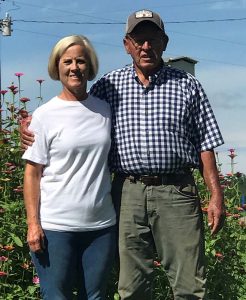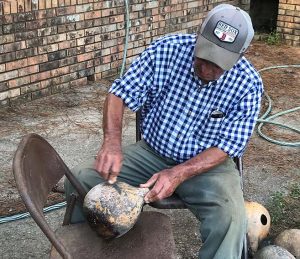

By CAROLYN DRINKARD
Special to Atmore News
Native Americans have had a special connection to purple martins for centuries. They erected gourd houses to attract these fascinating creatures, and in exchange, the birds kept insects off their crops and drove crows and other birds away from their corn. This cooperation between man and bird lives on today in Southwest Alabama, as southerners erect gourd trees and anticipate the arrival of these special little birds each spring.
One person, who keeps a close eye on these visitors, is Weldon Vickrey. Known as “The Purple Martin Man,” Weldon is a sixth-generation Creek Indian on his mother’s side. He said his love for these birds came from his Indian heritage. He proudly tells the story of how purple martins saved his ancestors when a malaria epidemic hit here. Hundreds died in surrounding communities, but no Indians lost their lives because purple martins had killed the mosquitoes and eaten the mosquito larvae, freeing his people of the dreaded disease.
Weldon’s passion for purple martins became a personal mission in 1962, after he learned that less than 90,000 martins were left in the U.S. About this time, he purchased a new, aluminum martin house and found a small pamphlet inside, inviting bird lovers to contact the manufacturer, Nature House, owned by J.L. Wade. Weldon soon developed a close friendship with Wade. In fact, Wade invited Weldon to serve on the company’s board and called often to ask about purple martins. Wade even asked Weldon to help with a problem that the company was having with the new aluminum birdhouse. Purple martins would not go into the house! Weldon solved this problem by building an umbrella to hold gourds and then placing the aluminum house on top. When older martins came, they nested in the gourds. After the mother birds ran the little ones away, the fledglings went into the aluminum house on top. Weldon’s solution received widespread publicity. Later, J.L. Wade wrote a book about martins, including many things Weldon Vickery had shared.
Weldon Vickrey has lived a life filled with good works and community service. For years, he lived near Atmore, coaching Babe Ruth baseball and working at a paper mill in Brewton. He served four terms on the Escambia County Commission. In 1989, Weldon Vickery spent $5,000 of his own money to place birdhouses all over Escambia County, Ala. That same year, he petitioned the Alabama Legislature to declare Atmore the “Purple Martin Capital of Alabama.” The citizens of Atmore honored Weldon by inducting him into the Atmore Area Hall of Fame.
After Weldon’s actions, 28 other states proclaimed themselves “purple martin states.” A short while later, purple martins were taken off the endangered species list.
“I felt good about being a part of bringing these birds back,” Weldon reflected. “They’re real special to me!”
In November 2000, Weldon and Kay Vickrey moved to the small community of Mineola in Monroe County. The area was heavily infested with mosquitoes, so the couple quickly put up 5 racks of short-necked gourds to attract purple martins. Soon, the Vickery farm was mosquito-free, thanks to the martins.
Weldon explained how purple martins actually rid an area of mosquitoes. As the insects mate in mid-air, purple martins spread their wings and literally vacuum them into a V-shaped pocket under each wing. Inside that pocket are hairy patches that trap mosquitoes.
After a car had hit one of his birds, Weldon examined the body and found something amazing.
“I pulled 47 mosquitoes from its wings,” Weldon said. “People see the birds sitting on lines, picking underneath their wings, so they think the birds have mites. They are actually rolling up mosquitoes to eat or feed their babies.”
Each year, Weldon Vickery grows thousands of short-necked gourds. Following the tradition of his ancestors, he plants seeds on a dark night in May. After harvesting, he cleans and paints the gourds he will use for martin nesting.
“I’ve never sold a gourd,” he chuckled, “but I have given away thousands.”
He also saves gourd seeds and gives them away at the Atmore Truckers’ Cooperative and the Farmers’ Cooperative Market in Frisco City. Anyone who visits his farm leaves with a packet of seeds.
Weldon works to help martins to thrive. Since the birds have many enemies, Weldon places red, blinking solar lights around the bottoms of his racks to scare away owls, snakes or raccoons. He also puts a plastic owl atop the poles to frighten away hawks.
Most people are surprised to learn that Purple Martins are really not purple! At age two, the birds turn a dark bluish-black that has a purplish sheen in sunlight. The birds are also incredible acrobats, darting and diving, often scooping water into their bills while moving.
Weldon Vickrey and his purple martins speak a common tongue. “Martins are like dogs and cats,” he explained. “They know me. I talk to them, and they chatter back to me. But let a stranger come up, and they will dive at him.”
Now at 85, Weldon is grateful for all he has been given. With a deep respect for living, growing things and a spiritual connection to the earth, Weldon Vickrey wears the title of “purple martin man” with honor.
“I love nature,” he said, “and I love these birds. I feel a kinship to them. Nobody in this world is blessed more than I have been to live the life I have!”
Carolyn Drinkard writes for Alabama Cooperative News magazine. Her article on Weldon and Kay will be published in the September magazine.

[…] began in precolonial North America, perhaps near the homes of the Choctaw, Chickasaw, and other Native American tribes that would hollow out gourds and hang them to dry for later storage use. For […]
[…] began in precolonial North America, perhaps near the homes of the Choctaw, Chickasaw, and other Native American tribes that would hollow out gourds and hang them to dry for later storage use. For […]
[…] began in precolonial North America, perhaps near the homes of the Choctaw, Chickasaw, and other Native American tribes that would hollow out gourds and hang them to dry for later storage use. For […]
[…] began in precolonial North America, perhaps near the homes of the Choctaw, Chickasaw, and other Native American tribes that would hollow out gourds and hang them to dry for later storage use. For […]
[…] precolonial North America, maybe close to the properties of the Choctaw, Chickasaw, and different Native American tribes that might hole out gourds and dangle them to dry for later storage use. For no […]
[…] in precolonial North America, maybe close to the houses of the Choctaw, Chickasaw, and different Native American tribes that will hole out gourds and dangle them to dry for later storage use. For no […]
[…] began in precolonial North America, perhaps near the homes of the Choctaw, Chickasaw, and other Native American tribes that would hollow out gourds and hang them to dry for later storage use. For […]
[…] precolonial North America, maybe close to the properties of the Choctaw, Chickasaw, and different Native American tribes that might hole out gourds and dangle them to dry for later storage use. For no […]
[…] began in precolonial North America, perhaps near the homes of the Choctaw, Chickasaw, and other Native American tribes that would hollow out gourds and hang them to dry for later storage use. For […]
[…] began in precolonial North America, perhaps near the homes of the Choctaw, Chickasaw, and other Native American tribes that would hollow out gourds and hang them to dry for later storage use. For […]